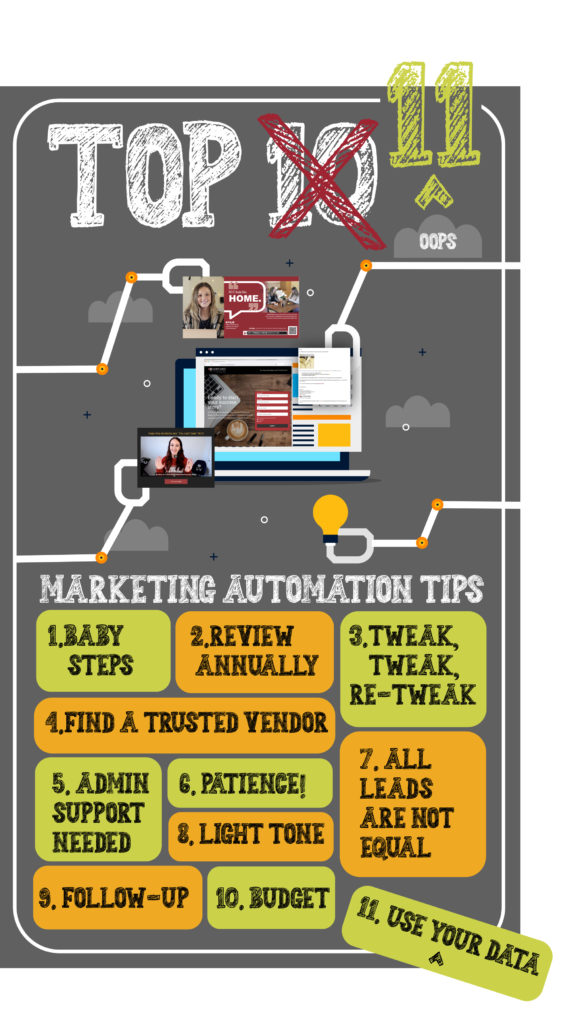Marketing professionals are always asked to do more, often with the same small budget. And when times are hard, purse strings tighten even further. Enter marketing automations, which can alleviate some of the constant strain of not enough money, not enough time and not enough staff.

Marketing automations are communications that are automatically triggered by prospective students choosing different options during their enrollment journey. For instance, a prospect clicks an ad, is sent to a landing page and fills out a lead form. That triggers a series of emails, voicemails and texts that look like they’re coming from a responding recruiter. These communications lead the prospect through a marketing funnel as they try to narrow down their interest in the college.
Depending on the automation the prospect enters, they might not get to a human recruiter until two to four responses later. Meanwhile, some automations lead the prospect straight to an application, and they will only get routed to a recruiter if they need specific help.
This article is part of a monthly series provided by the National Council for Marketing & Public Relations (NCMPR), an affiliated council of the American Association of Community Colleges.
Northwest Iowa Community College (NCC) marketing team has 2 ½ full-time employees, and marketing automations have helped the college deal with the need for more, be it more budgeting dollars (or stretching budgeting dollars), more time or more staff. Plus, the process helps the recruiter team because a lot of the beginning footwork is already done by the time they get involved. When they meet the prospect, recruiters already understand what the prospect is interested in. Because the prospect has jumped through a few virtual hoops on their own, recruiters also know the prospect is truly interested in the college.
NCC started using automations about 10 years ago, and the college has learned a few best practices to help others get started.
1. Take it in small steps.
Don’t try too much or be too complicated in the beginning. Start off by promoting one thing. For example, NCC started by promoting a new program. Colleges can always add components to future automations, such as abandonment, lead scoring, automated voicemails and texting.
2. Review all of your automations once a year, and take notes during the year.
It’s important to take notes during each campaign about what worked and what didn’t. When a leader sits down with their team at the end of the year, these notes make it easier to decide where to invest dollars. The next steps don’t always need to be another huge project. Maybe the best spend is to improve what’s already successfully in place. It’s also helpful to look at how all automations work together to recruit students.
3. If at first you don’t succeed, tweak, tweak and re-tweak.
Nothing is ever perfect, and there is always some room for improvement before launching another campaign, such as a list of contacts, ads or response time. The beauty of automations is the changeable approach. Nothing is set in stone, and changes can be made on the fly.
4. Find a trusted vendor partner.
It took the team at NCC five years to find a partner with whom it was fully comfortable. Do the research and interview multiple vendors. The college and vendor will work together closely, so it’s important for the vendor to share the college’s vision and department culture. Trusting one another is vital to this mix. A vendor is an extension of the marketing department. They’re the staff the college wants to hire but can’t due to budget constraints.
5. Administrative support is important.
This is a big one, especially for marketing teams working across multiple departments. At NCC, marketing and enrollment are in two different divisions, so responding to electronic leads needs to be a clear priority from the top down. If the administration doesn’t prioritize responding to leads, it might be seen as “other duties as assigned” and could fall by the wayside. Clear communication from all involved parties is strategic for automation success.
6. Patience, patience, patience.
If automation requires working across division boundaries, go slow. Adding work to other people’s plates is a balancing act – especially across divisions. Allow other division partners time to reflect, comment and think about the proposal before throwing new duties and expectations at them. They need to be included in the discussion and feel heard. At NCC, marketing meets with the enrollment team leader on a regular basis. The groups have one big meeting with all the recruiters, and the vendor, at least once a year to review how the automations are working, or not working, for them.
7. Not all leads are equal.
Gone are the days that prospective students fill out a lead form that goes directly to a recruiter. The leads from NCC’s automations usually have to go through about three automation virtual hoops before they get to a live recruiter. If a prospective student has jumped through three hoops to get to a recruiter, they’re ready to talk.
8. Conversational messaging and a light tone seem to work best.
There’s a balance to finding the right tone for your area, though NCC has found success with conversational messaging. Play around a bit. Use some A/B testing to find out what the population responds to. Even if the college uses the same campaign from year to year, review and refresh the copy so the messaging is right for the moment. Especially during the height of the pandemic, NCC’s messaging became more informal and focused on support.
9. Don’t be afraid to send a follow-up communication asking questions about the campaign.
Follow email open rates. If prospective students consistently open emails, hit landing pages, open abandonment emails and click back to the landing page, but then they don’t follow through with a lead or event registration form, ask them why. The NCC team noticed just that in a recent campaign. It was obvious those prospects were interested in the college, but NCC needed to learn what piece of information was missing. It emailed those prospects to learn what would have nudged them to take the next step.
10. Develop a budget.
This sounds elementary, but it’s easy to go down a rabbit hole of money because the extras all sound so wonderful. It’s better to take time to reflect on a campaign and decide if it needs additional funds during an annual meeting review of the automation plan. Involved parties can look at the campaigns together and review each campaign’s effectiveness. It will become clearer which campaign is the most important so dollars can be assigned accordingly.
11. Bonus tip! Don’t underestimate the prospect or the college’s internal data files.

Don’t count people out of data sets without concrete rationale. One of the biggest lessons learned in the beginning of NCC’s automation journey was to not shrink recruitment pools based on notions of what may or may not have worked in the past. Cast a big net when starting a campaign. Then start targeting based on results.
Use your continuing education department’s data. They have a wealth of information and specific data. If the college is starting a class in web and graphic design, for instance, pull data from the last three to five years to learn who took a class that had anything to do with web, graphic design, photography, art, etc., and include those students as prospects.
If students had an enjoyable experience, why not advertise a credit class to them? They are already familiar with the brand, so they don’t have to start learning about the college from scratch. If they’re not interested, they’ll simply unsubscribe, or perhaps they have children or extended family and friends who would be interested.
Remember, figuring out automation for your college is a marathon, not a sprint.





